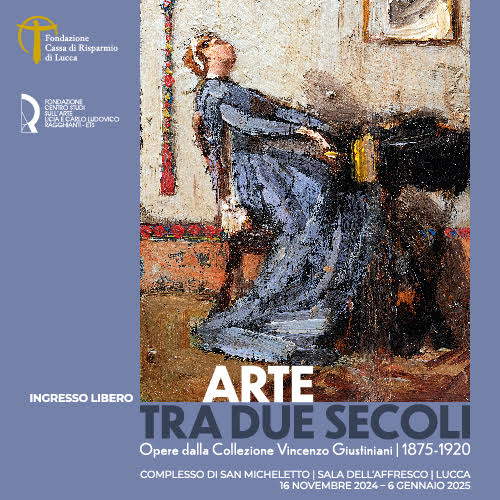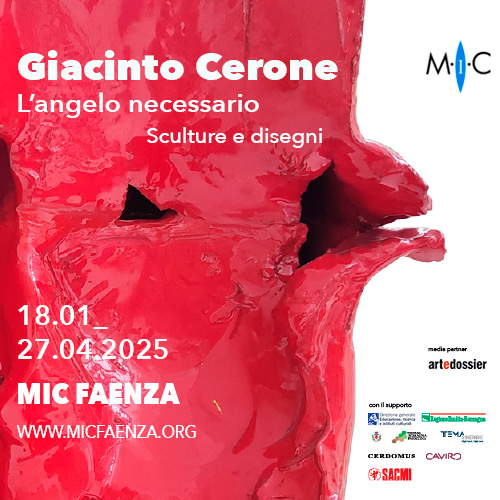by Federico Giannini, Ilaria Baratta , published on 02/09/2015
Categories: Travel
/ Disclaimer
Traveling through the ancient village of Trebiano Magra, among wonderful works of art and evocative legends...
As soon as we enter the narrow streets of the hamlet of Trebiano Magra, we are greeted by an insistent meowing: accomplices being the absolute quiet, the poor reputation of this little village clinging to the slope of a hill, the impossibility of venturing through the alleys by car, and the fact that the houses are now almost completely uninhabited (there are barely a hundred inhabitants left, roughly), Trebiano seems to be populated more by cats than by humans. There are some that, probably more accustomed to the presence of humans, allow themselves to be approached and, indeed, as soon as they see our peaceful intentions, go back to sleep. Others, however, are more wary and run away over the ancient stone walls to have nothing to do with us: you never know. In one of the alleys there are even four of them all together, lying down to rest: as we pass they do not flinch an inch and look at us as if to say “do as you wish, but we are not moving from here.”
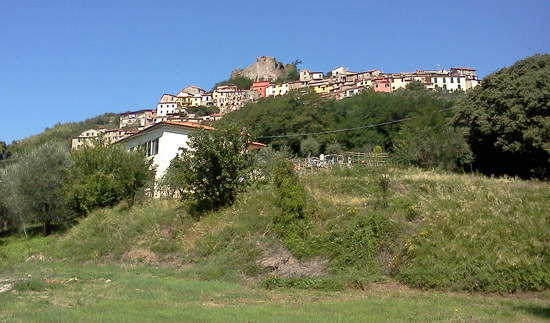 |
| Trebiano Magra |
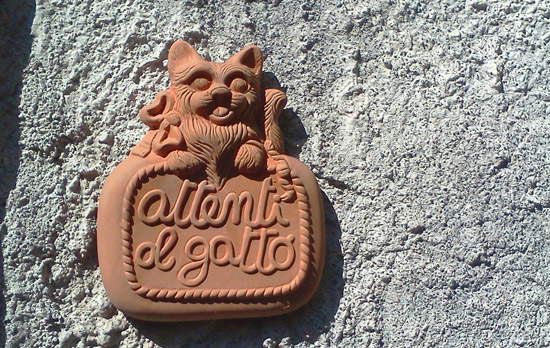 |
| You are warned... |
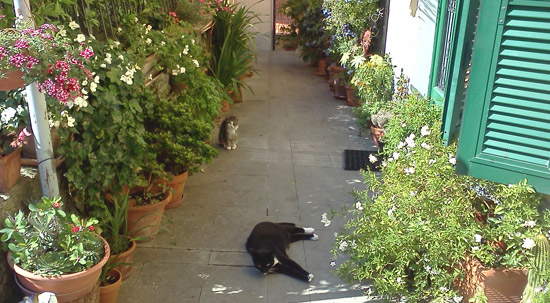 |
| The sleepy cats of Trebiano. |
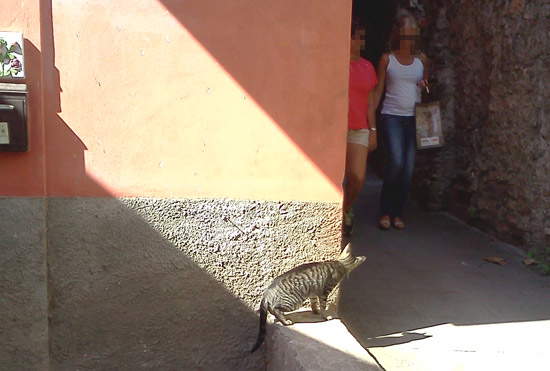 |
| A curious kitten observes two passersby. |
To climb up to Trebiano, one must go up from Romito Magra, which like Trebiano is a hamlet of the municipality of Arcola (we are still in eastern Liguria): at the traffic circle where the road to Lerici begins, one must then continue and on the left one will notice, a few meters ahead, a faded and almost hidden sign indicating the ascent to Trebiano. After a little less than three kilometers on a scenic road, between hairpin bends, olive trees and beautiful views, you will arrive at the village. Before entering, we see on the right the only church in Trebiano, dedicated to St. Michael the Archangel: we enter it because there are illustrious works of art preserved inside.
The parish church has a rather elaborate Baroque façade on the outside, with two volutes connecting the pediment to the lower part of the façade, and with an elegant broken tympanum housing the statue of St. Michael. The interior, with three naves, is rich in works of art. In a chapel that opens on the right, we notice an altar at the center of which stands a wooden statue of Saint Roch, flanked by that of two other saints: the Saint Roch is the work of 1524 by Domenico Gar, a French sculptor very active in these areas, and it is a very important sculpture because, at the present state of knowledge, it would seem to be the first known work by this artist. Devotion to St. Roch has always been particularly alive in this corner of Liguria (and moreover, the saint is the patron saint of Trebiano), and here Domenico Gar depicts him with the unusual (but typical of Gar) detail of the angel healing the wound on his leg. In the opposite aisle we find another work by Gar: the marble triptych with the Madonna and Child in the center and Saints Bernard and Catherine of Alexandria on either side. Here, too, Gar revisits traditional iconographies: Catherine, interestingly, subdues the Roman emperor Maximian, under whom the saint suffered martyrdom. The triptych was commissioned for the Mascardi Chapel, one of Sarzana’s most prominent families, in 1524, and was completed in 1529. The commissioner, Jacopo Mascardi, had probably been impressed by the previous test of the Saint Roch and had decided to commission Domenico Gar to create the challenging marble work. It was a work of great quality, showing that the French artist was up to date and well within the context of 16th-century Tuscan sculpture. And a work so beautiful that it was later called theIcona pulchra that is, precisely, the “beautiful icon.”
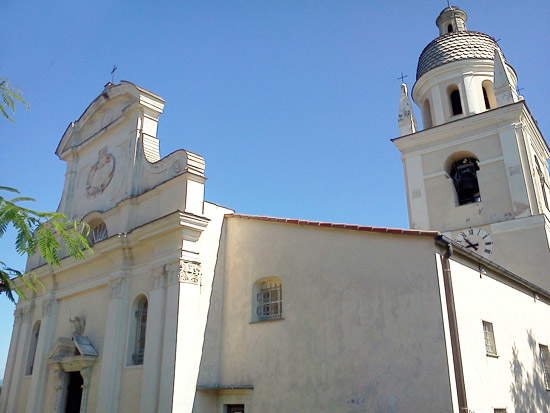 |
| The parish church of San Michele |
A fifteenth-century crucifix and an additional cross, probably coeval, stand out, which in the seventeenth century was “integrated” with four panels painted by a Tuscan artist, Filippo Martelli, a native of Versilia: we are in 1634, and today what remains of the original cross can be glimpsed from the oval in the center of the very curious composition that was commissioned to Martelli precisely for the purpose of preserving the cross. Also of interest is a marble stoup made from marble from the Roman period, probably from an ancient votive altar.
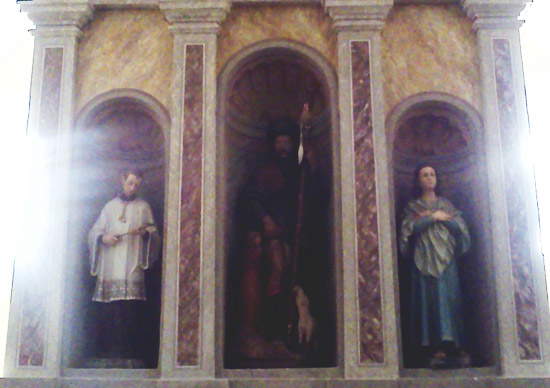 |
| Saint Roch (center) by Domenico Gar |
Having finished our visit to the church, we proceed into the village, which besides being one of the most picturesque, is also one of the largest in the area. And to visit it we start from the gateway, which has medieval origins. Trebiano is in fact first mentioned in a document from 963, but the origins of the settlement are perhaps even older, and the toponym itself is supposed to refer to the funds of a Roman family, the Gens Trebia, who had estates in the area. From the gate, one road goes up and one road goes down: we take the one that goes slightly uphill. It is the main one in the hamlet and runs the length of the hamlet, among ancient gateways, colorful bougainvillea and more cats, and then comes, at the end, to a stairway that turns abruptly in the opposite direction and takes us to a higher level. Indeed, it seems that the village was built on terraces clinging to the hillside, all on top of each other, and the houses are arranged on either side of these narrow streets that run the length of them. And every now and then, in the middle of the street, narrow stairways open up that, making their way between the buildings, offer us shortcuts to access the upper level. Every now and then, small squares or balconies open on the street, offering us spectacular views of the Magra plain: we see the winding course of the river that then flows into the Ligurian Sea, we see on the left the sharp profile of the Apuan Alps, we see the towns of the plain.
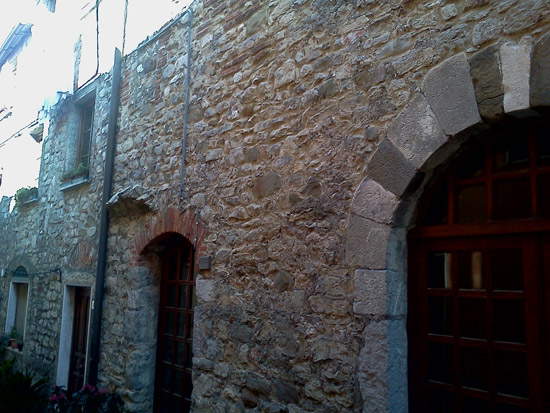 |
| The stone walls of the ancient buildings of Trebiano |
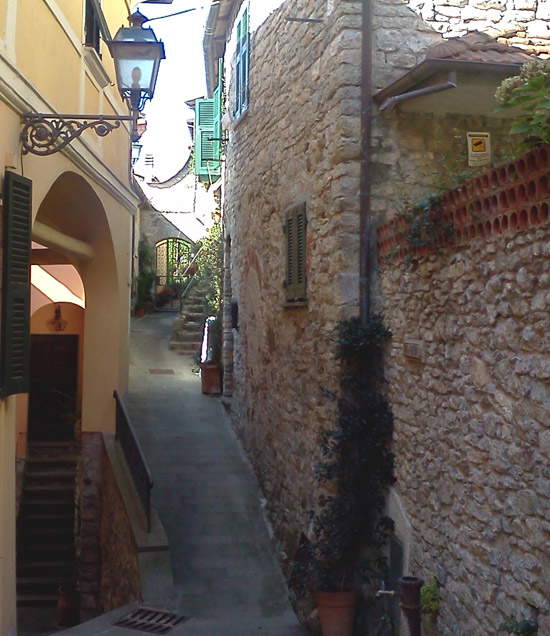 |
| One of the many picturesque alleys of Trebiano |
 |
| The splendid view of the Magra plain |
And so we understand what the strategic importance of this village was in earlier times, when it constituted an important garrison to control traffic in the Magra valley and access to the port of Lerici, a small port of call for ships bound for Genoa. Thus, Trebiano also experienced different rulers: it was first of the Bishops of Luni, then came under the control of Pisa, and finally, in 1254, it was purchased by the Genoese. The mighty castle is perhaps the most conspicuous witness of those times: even though it is now a ruin, it is still massive and imposing, with the remains of its towers, its mighty arches, its strong walls, and its silhouette that dominates the whole town and can be distinguished even from miles away. Unfortunately, today the castle is unsafe and unusable. We meet an old woman from the village, who tells us about when, decades ago, it was still possible to go up to the castle, when there was more life in the village and when institutions cared more about their historical memory. When we attempt to approach the castle, the uncultivated brushwood surrounding it seems to confirm the elderly resident’s version. At some point the grass reaches knee height, the path is covered by vegetation, and signs and barriers begin to appear warning us of the dangers we might face in pushing higher. We therefore decide not to venture any further: we make just enough time to observe what was perhaps in ancient times a portion of the surrounding wall, now in ruins.
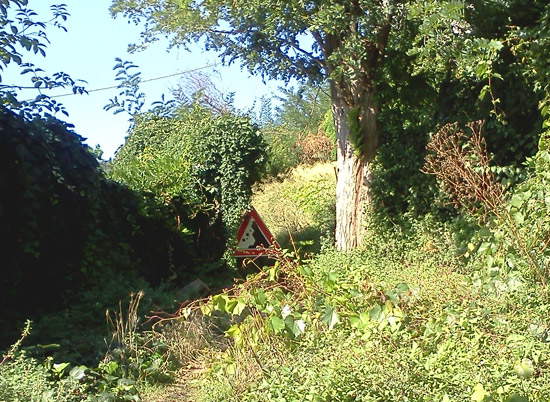 |
| The condition of the path leading to the castle |
Yet this hamlet of steep lanes would have many stories to tell. Starting with what is perhaps the most evocative legend about it: in fact, the imagination of the inhabitants of Trebiano would have it that hidden in one of the castle’s ravines is the original manuscript of Dante Alighieri’s Divine Comedy, which would never be found by all those who searched for it. And, as with every legend, there is a kernel of truth, because as is well known the supreme poet really did sojourn in these lands during his exile from Florence: as we told you when we told you about the Castle of the Bishops of Luni in Castelnuovo Magra, in 1306 Dante played the role of procurator for Marquis Franceschino Malaspina during the negotiations of the so-called “Peace of Castelnuovo” that ended a seven-year war between the Malaspina and the Bishops of Luni. And in Trebiano for a long time also lived (and this is history) the French artist Helène de Beauvoir (1910 - 2001), sister of the more famous Simone de Beauvoir (1908 - 1986), who in some of her writings recounts the beauty of the village after visiting Helène. And from Trebiano came the family of Domenico Fiasella (1589 - 1669), one of the greatest painters of seventeenth-century Liguria.
Today, Trebiano is a village unknown to most, animated a little more than usual only in the summer, when tourists from northern Italy arrive to take advantage of their second homes, because from here the sea can be reached in ten minutes by car, and rental prices are lower than in seaside towns. And apart from a couple of bed and breakfasts, there is no structure of any kind in the village. Nor are there any panels or signs telling the history of Trebiano to the traveler who goes out of his way to visit the hamlet. A few months ago, a young architect proposed a project to revive the castle, but everything still seems to be at a standstill. We make no secret of the fact that it would be really nice and exciting to see this hidden gem among the hills of the Magra Valley flourish again.
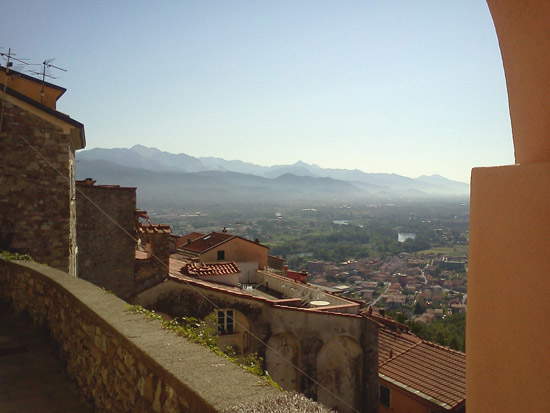 |
| Panorama from a balcony in Trebiano |
| The facade of San Michele... | ... and the statue that adorns it |
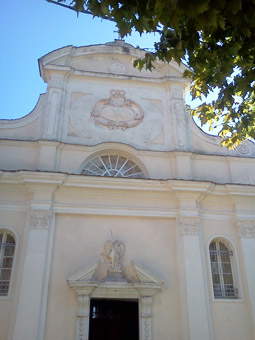 |
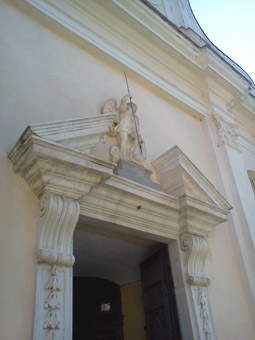 |
| The 15th-century crucifix | The work of Filippo Martelli |
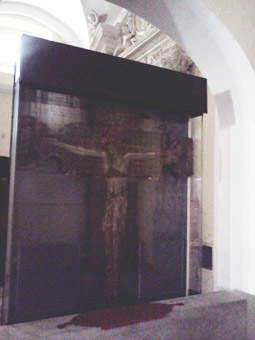 |
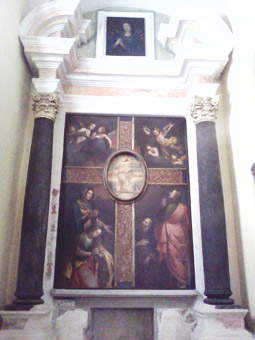 |
| The marble triptych by Domenico Gar | The stoup carved from Roman marbles |
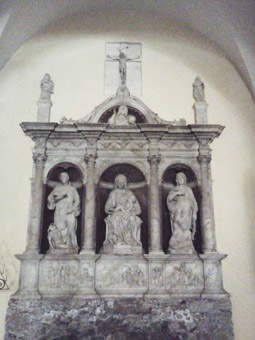 |
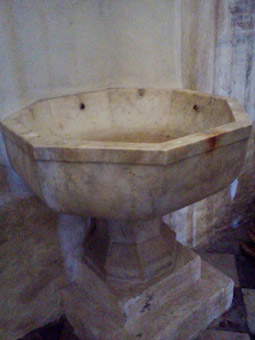 |
| An archivolt... | ... and a staircase in the hamlet |
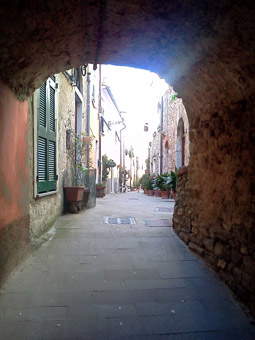 |
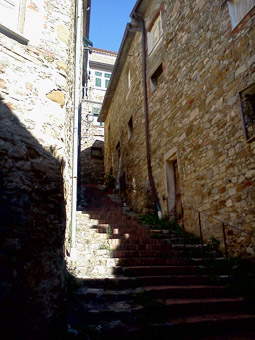 |
| The village’s main street ... | ... and a colorful corner of it |
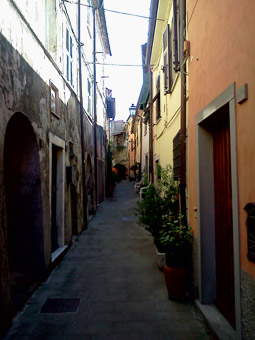 |
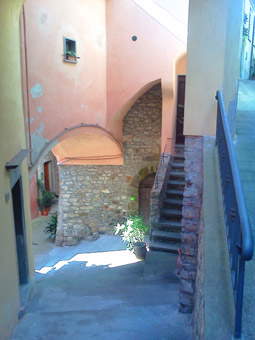 |
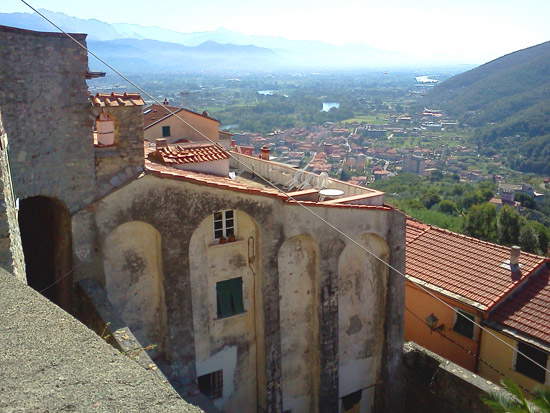 |
| The borough from above |
| Glimpse into the upper part of the borgo | Typical staircase paved in terracotta tiles |
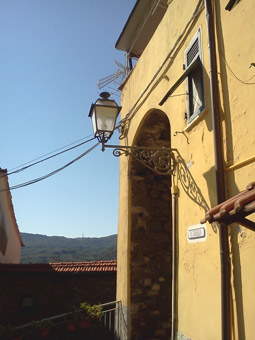 |
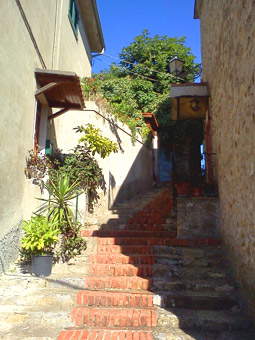 |
| Glimpse into the upper part of the hamlet | A colorful bougainvillea in a narrow street |
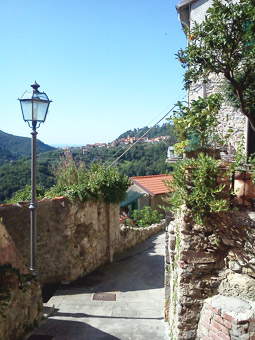 |
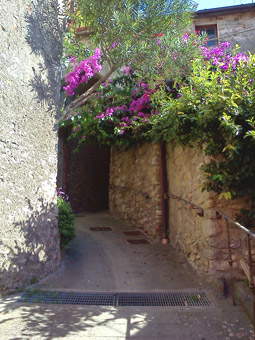 |
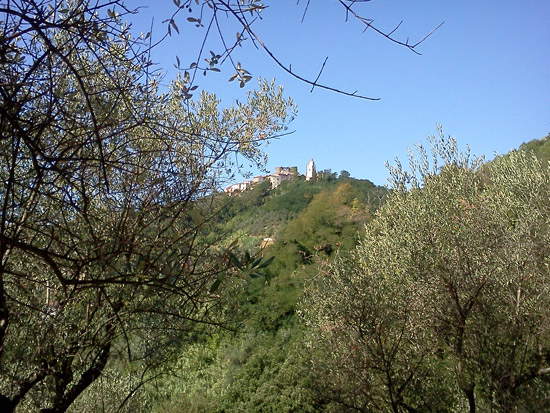 |
| A beautiful view of the hamlet from the olive trees on the slope leading up to Trebiano |
Warning: the translation into English of the original Italian article was created using automatic tools.
We undertake to review all articles, but we do not guarantee the total absence of inaccuracies in the translation due to the program. You can
find the original by clicking on the ITA button. If you find any mistake,please contact us.


































